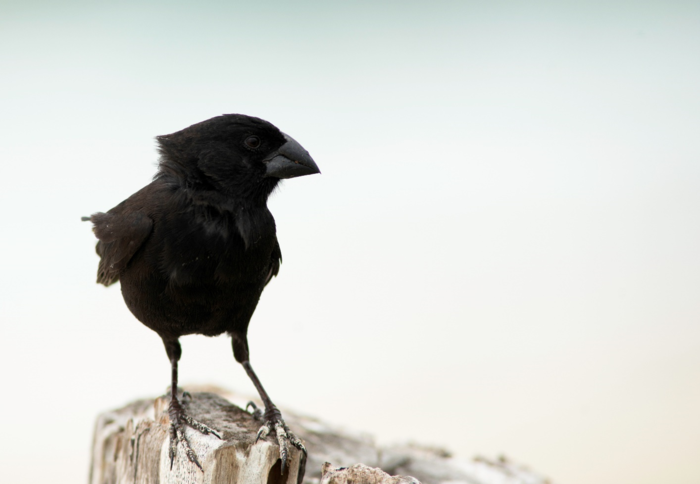Using radio transmitters, scientists have gained new insights into the behaviour of medium ground finches in the Galapagos Islands. A study led by McGill University researchers reveals daily movement patterns covering an area equivalent to the size of 30 soccer fields.

Credit: Andrew Hendry
Using radio transmitters, scientists have gained new insights into the behaviour of medium ground finches in the Galapagos Islands. A study led by McGill University researchers reveals daily movement patterns covering an area equivalent to the size of 30 soccer fields.
Until now researchers knew little about the secret lives of these birds, due in part to challenges studying them in their natural habitat, involving rough volcanic rock terrain and harsh climate conditions. For the first time, scientists tracked the birds’ movements day and night by tagging them with tiny electronic backpacks weighing just half a gram. The research, carried out in a remote coastal area of the island of Santa Cruz, was published in Ecology and Evolution.
Habitat threatened by urban expansion
In addition to the extraordinary distances travelled by the finches, the study showed that foraging areas increased during the nestling and feeding phase, when parents needed to find more food. “Understanding the real space needs of these birds is crucial both to refine the interpretation of previous studies and to ensure the conservation of these birds in a landscape increasingly threatened by the expansion of urban areas,” says lead author Marc-Olivier Beausoleil, a PhD student under the supervision of McGill Professor Rowan Barrett in the Department of Biology.
The finches established their breeding territories in an arid forest with incense trees (Bursera graveolens) and arborescent cacti. The males spent most of their time building the nests in a frantic back-and-forth search for materials, while the task of incubation fell entirely to their mates. Location tracking during daytime showed that the finches rarely strayed more than a hundred meters from their nests to search for food or building materials. So why did they need so much space?
Birds of a feather flock together, even at night
Most birds rarely gather to roost while breeding, unless they nest in groups like colonies of penguins or roosts of starlings. Surprisingly, the team found that Darwin’s finches are a clear exception. “Almost all the tagged finches left their breeding territories after sunset and moved four times the distance they normally cover in the daytime. The mysterious destination: a lush grove of poison apple trees (Hippomane mancinella) located by the sea where nearly a thousand finches gather nightly to rest,” says Beausoleil.
While it’s common to observe large groups of finches in the highlands of the islands outside the breeding season, the researchers didn’t expect to find evidence of such social behavior at the height of breeding.
“Sleeping in the company of others helps the birds fight the cold and reduces the risk of predation. Although the advantages of this behavior are not as evident in a place where temperatures are mild and predators are scarce. This leads us to think that this behaviour may have been inherited from their continental ancestors,” says Carlos Camacho, a researcher at Instituto Pirenaico de Ecología and coordinator of the study.
The legacy of Darwin’s famous finches
Nearly 150 years after Darwin’s death, his famous finches continue to spark the interest of scientists. The species has been inextricably linked to the British naturalist ever since he outlined his theory of natural selection nearly 150 years ago, after visiting the Galapagos Islands and witnessing its extraordinary biodiversity. Darwin’s finches are currently one of the most-studied organisms on the planet. Thanks to them we know how rapid evolutionary changes can occur and how the exchange of genetic material between different populations can spur the emergence of new species.
The results of this work raise new and exciting questions for scientists, while providing very useful information for the conservation of biodiversity and ecosystems that are unique on our planet.
About this study
“Where did the finch go? Insights from radio telemetry of the medium ground finch (Geospiza fortis)” by Marc-Olivier Beausoleil, Carlos Camacho, Julio Rabadán- González, Kristen Lalla, Roxanne Richard, Paola Carrion- Avilés, Andrew P. Hendry, and Rowan D. H. Barrett was published in Ecology and Evolution.
DOI: https://doi.org/10.1002/ece3.8768
Journal
Ecology and Evolution
DOI
10.1002/ece3.8768
Method of Research
Observational study
Subject of Research
Animals
Article Title
Where did the finch go? Insights from radio telemetry of the medium ground finch (Geospiza fortis)
Article Publication Date
26-Apr-2022




